#Rani Ki Vav: A Magnificent Stepwell of India
Explore tagged Tumblr posts
Text
Wander the Royal Roads of the Deccan Odyssey
The Deccan Odyssey train route offers an unparalleled experience, blending luxury and cultural richness as it glides through India’s most captivating landscapes. As one of the most esteemed luxury trains in India, the Deccan Odyssey route takes travelers on an extraordinary expedition through the royal heritage of the Deccan Plateau. With a focus on elegance, history, and comfort, this journey promises to reveal the soul of India through its grand palaces, ancient temples, and vibrant cities.

Unveiling Mumbai: The Gateway to Luxury

Mumbai, often regarded as the heartbeat of India, marks the beginning of this prestigious journey. As the starting point of the Deccan Odyssey train route, Mumbai offers a mix of historic charm and modern marvels. The city’s colonial architecture, bustling markets, and serene seafronts set the stage for what lies ahead. From the moment travelers step aboard the Deccan Odyssey, they are enveloped in a world of opulence, where every detail is meticulously crafted to provide an unforgettable experience.
The Regal Appeal of Vadodara

As the Deccan Odyssey route winds its way to Vadodara, travelers are treated to the splendor of this city, known for its royal lineage and artistic heritage. Vadodara, once the seat of the Gaekwad dynasty, is home to the magnificent Laxmi Vilas Palace, a testament to the city’s regal past. The palace, with its intricate architecture and sprawling gardens, offers a glimpse into the grandeur of India’s princely states. The Deccan Odyssey train route ensures that travelers immerse themselves in the cultural richness of Vadodara, making it a highlight of the journey.
Enchanting Sasan Gir: The Land of the Lions

The Deccan Odyssey route takes an adventurous turn as it arrives at Sasan Gir, the last refuge of the majestic Asiatic lion. Sasan Gir National Park is a sanctuary that is both awe-inspiring and humbling. Here, travelers can witness the rare and endangered lions in their natural habitat, a sight that few are privileged to see. The Deccan Odyssey train route ensures that this once-in-a-lifetime experience is both thrilling and safe, allowing guests to connect with nature in a profound way.
The Architectural Marvels of Modhera and Patan
Continuing along the Deccan Odyssey route, travelers reach the ancient cities of Modhera and Patan, where history comes alive through exquisite architecture and intricate craftsmanship. The Sun Temple at Modhera, dedicated to the Hindu sun god Surya, is a masterpiece of stonework, with carvings that depict scenes from ancient epics. Patan, known for its UNESCO-listed Rani ki Vav stepwell, is another gem on the Deccan Odyssey train route. These sites offer a window into the spiritual and cultural history of India, making this leg of the journey deeply enriching.
Udaipur: The City of Lakes

As the Deccan Odyssey train route approaches Udaipur, travelers are welcomed into a city renowned for its lakes, palaces, and romantic ambiance. Udaipur, often referred to as the Venice of the East, is a city that exudes charm at every corner. The City Palace, with its breathtaking views of Lake Pichola, is a marvel of Mewar architecture and a focal point of the Deccan Odyssey route. A boat ride on Lake Pichola, with the Aravalli hills in the background, adds a touch of serenity to the luxurious voyage.
Jodhpur: The Blue City and Beyond
Jodhpur, famously known as the Blue City, is a vibrant stop on the Deccan Odyssey route. The city’s distinctive blue-washed buildings create a stunning contrast against the arid landscape. Mehrangarh Fort, one of the largest forts in India, stands as a guardian over the city, offering panoramic views and a deep dive into Rajasthan’s history. The bustling bazaars of Jodhpur, where travelers can find everything from spices to textiles, provide a lively backdrop to this regal stop on the Deccan Odyssey train route.
The Grandeur of Jaipur

No royal tour of India would be complete without a visit to Jaipur, the Pink City. The Deccan Odyssey train route brings travelers to this majestic city, known for its pink-hued buildings, grand palaces, and vibrant culture. The Amber Fort, perched high on a hill, is a stunning example of Rajput architecture and a key highlight of the Deccan Odyssey route. The City Palace, with its fusion of Rajput and Mughal styles, offers a glimpse into the opulent lifestyle of Rajasthan’s rulers. Jaipur’s lively markets and rich cultural heritage make it a fitting finale to the regal journey.
Exploring the Ancient Wonders of Aurangabad
Aurangabad, named after the Mughal emperor Aurangzeb, is a city steeped in history and intrigue. As the Deccan Odyssey train route makes its way to this ancient city, travelers are invited to delve into its rich past. The city is home to the famous Ellora Caves, a UNESCO World Heritage Site, which features rock-cut temples and monasteries that date back to the 6th century. The intricate carvings and massive sculptures are a testament to the artistry and devotion of the ancient Indian craftsmen. The Deccan Odyssey route ensures that travelers experience the cultural and historical significance of Aurangabad in a way that is both immersive and enlightening.
Kolhapur: A City of Tradition and Splendor
The Deccan Odyssey train route culminates in Kolhapur, a city that embodies the rich traditions and cultural heritage of Maharashtra. Kolhapur is known for its ancient temples, royal palaces, and vibrant markets. The Mahalakshmi Temple, dedicated to the goddess of wealth and prosperity, is a significant pilgrimage site and a key attraction on the Deccan Odyssey route. The New Palace, a fine example of Indo-Saracenic architecture, houses a museum that showcases the royal artifacts of the Kolhapur dynasty. The city’s cultural richness and historical significance make it a fitting end to the luxurious journey.
0 notes
Text
Rani Ki Vav: A Magnificent Stepwell of India
Rani Ki Vav….India is a country full of architectural wonders that never cease to amaze the world. One such marvel is the Rani Ki Vav, a UNESCO World Heritage Site situated in the small town of Patan in the western state of Gujarat. Rani Ki Vav, which literally translates to “Queen’s Stepwell,” is a magnificent structure that was built in the 11th century AD by Queen Udayamati in memory of her…

View On WordPress
#apnaran#blogs#education#india#litlikesunlight#ADMIN#apna ran#Rani Ki Vav#Rani Ki Vav: A Magnificent Stepwell of India
0 notes
Photo










Man's Impact on the Environment Rani-ki-Vav Patan, Gujarat, India
Rani ki vav is an intricately constructed stepwell situated in the town of Patan in Gujarat, India. It is located on the banks of Saraswati River. Rani ki vav was built as a memorial to an 11th-century king Bhima I by his beloved wife queen Udayamati. It was added to the list of UNESCO's World Heritage Sites on 22 June 2014. Stepwells are a distinctive form of subterranean water resource and storage systems on the Indian subcontinent, and have been constructed since the third millennium BC. Rani ki vav was built in the complex Maru-Gurjara architectural style with an inverted temple and seven levels of stairs and holds more than 500 principal sculptures.
Rani ki Vav bagged the title of “Cleanest Iconic Place” in India at the Indian Sanitation Conference (INDOSAN) 2016 in New Delhi in October 2016. The monument was felicitated at the conference, inaugurated by Prime Minister Narendra Modi.
Rani ki vav, or Ran-ki vav (Queen’s step well) was constructed during the rule of the Chaulukya dynasty. It is generally assumed that it was built in the memory of Bhima I (r. c. 1022–1064) by his widowed queen Udayamati and probably completed by Udayamati and Karna after his death. A reference to Udayamati building the monument is in Prabandha Chintamani, composed by the Jain monk Merunga Suri in 1304 AD.
The stepwell was later flooded by the nearby Saraswati River and silted over until the late 1980's. When it was excavated by the Archaeological Survey of India, the carvings were found in pristine condition.
This magnificent east-facing step well measures approximately 64 m long, 20 m wide & 27 m deep. A stepped corridor compartmented at regular intervals pillared multistory pavilions is a unique feature. It was one of the largest and the most sumptuous structures of its type. It became silted up and much of it is not visible now, except for some rows of sculptured panels in the circular part of the well. Among its ruins one pillar still stands which is an excellent example of this period of design. A part only of the west well is extant from which it appears that the wall had been built of brick and faced with stone. From this wall project vertical brackets in pairs, which supported the different galleries of the well shaft proper. The bracketing is arranged in tiers and is richly carved. The minute and exquisite carving of this vav is one of the finest specimens of its kind. Befitting its name, the Rani-Ki-Vav is now considered to be the queen among step wells of India.
There is also a small gate below the last step of the step well, with a 30-kilometre tunnel, currently blocked by stones and mud, which leads to the town of Sidhpur near Patan. It was used as an escape gateway for the king, who built the step well in the times of defeat.
Most of the sculptures are in devotion to Vishnu, in the forms of Dus-Avatars Kalki, Rama, Krishna, Narsinh, Vaman, Varahi and others representing their return to the world. Nagkanya, Yogini beautiful women – Apsara showcasing 16 different styles of make-up to look more attractive called Solah-shringar.
Around 50–60 years back there were ayurvedic plants around this area, and the water accumulated in Rani ki vav was considered to be helpful for viral disease, fever etc.
The vavs of Gujarat are not merely sites for collecting water and socializing, but also hold great spiritual significance. Originally, the vavs of Gujarat were constructed quite simply, but became more intricate over the years, perhaps to make explicit the ancient concept of the sanctity of water with the addition of carved stone deities. Thus visitors enter Rani Ki Vav as if it is an inverted temple, where one steps down various levels to the water.
The steps begin at ground level, leading you down through the cool air through several pillared pavilions to reach the deep well below. There are more than 800 elaborate sculptures among seven galleries. The central theme is the Dasavataras, or ten incarnations of Vishnu, including Buddha. The avatars are accompanied by sadhus, Brahmins, and apsaras (celestial dancers), painting their lips and adorning themselves. At water level you come to a carving of Sheshashayi-Vishnu, in which Vishnu reclines on the thousand-hooded serpent Shesha, where it is said he rests in the infinity between ages.
12 notes
·
View notes
Text
Experience Comfort and Convenience at our Lean Luxe Ginger Sanand Hotel near Railway Station
Sanand is a town in the Ahmedabad district of the Indian state of Gujarat. It is situated about 30 kilometers from Ahmedabad city and is known for its industrial development, particularly in the automobile sector.
Industrial development in Sanand is one of the fastest-growing industrial hubs in Gujarat. The city is home to major automobile manufacturers like Tata Motors, Ford, and Peugeot Citroen. It is also home to a number of ancillary industries that support the automobile sector. Festivals in Sanand celebrate many festivals throughout the year, including Diwali, Navratri, and Holi. During these festivals, the city comes alive with colorful decorations, music, and dance. Heritage sites in Sanand has a number of heritage sites that are worth exploring, such as the Akshardham Temple in Gandhinagar, the Rani Ki Vav stepwell in Patan, and the Modhera Sun Temple in Mehsana.
Connectivity: Sanand is well-connected to other parts of Gujarat and India. The city is located on the National Highway 947, which connects it to Ahmedabad and other major cities in the state. The nearest airport is Sardar Vallabhbhai Patel International Airport in Ahmedabad, which is about 40 kilometers away.
Here are some interesting things to do in and around Sanand:
Visit the Tata Nano plant: Sanand is home to the Tata Nano plant, where the world's cheapest car was manufactured. Visitors can take a guided tour of the plant and see the production process.
Explore the Sanand Bird Sanctuary: The Sanand Bird Sanctuary is a protected area that is home to a variety of bird species. Visitors can enjoy bird watching and nature walks in this peaceful setting.
Visit the Akshardham Temple: The Akshardham Temple in Gandhinagar, about 25 kilometers from Sanand, is a magnificent temple complex that is dedicated to Lord Swaminarayan. Visitors can marvel at the intricate carvings and architecture of the temple.
Enjoy the local cuisine: Sanand is known for its delicious local cuisine, particularly the Gujarati thali, which is a platter of various vegetarian dishes. Visitors can try out the many restaurants and street food stalls in the town.
Visit the Rani Ki Vav stepwell: The Rani Ki Vav stepwell, located in Patan about 100 kilometers from Sanand, is a UNESCO World Heritage Site. It is a beautifully crafted stepwell that was built in the 11th century.
Akshardham Temple, Gandhinagar: Located about 40 kilometers from Sanand, Akshardham Temple is a stunning Hindu temple known for its architecture and intricate carvings.
Adalaj Stepwell, Gandhinagar: Also located about 40 kilometers from Sanand, Adalaj Stepwell is a five-story stepwell that dates back to the 15th century. It is known for its stunning architecture and intricate carvings.
Sabarmati Ashram, Ahmedabad: Located about 30 kilometers from Sanand, Sabarmati Ashram is the former home of Mahatma Gandhi and is now a museum dedicated to his life and work.
Kankaria Lake, Ahmedabad: Located about 35 kilometers from Sanand, Kankaria Lake is a popular recreational spot in Ahmedabad, offering boating, a zoo, and a kids' park.
Lothal, Ahmedabad: Located about 70 kilometers from Sanand, Lothal is an archaeological site dating back to the Indus Valley Civilization and is known for its well-preserved ruins and artifacts.
Nal Sarovar Bird Sanctuary, Ahmedabad: Located about 65 kilometers from Sanand, Nal Sarovar Bird Sanctuary is a wetland area known for its diverse bird population and scenic beauty.
Overall, Sanand is a great place to visit if you are interested in industrial development, bird watching, local cuisine, and historical sites.
Ginger Hotel Sanand is a comfortable and affordable hotel in Sanand near railway station, Gujarat, India. Here are some features and amenities that make it a great place to stay:
Comfortable rooms: The hotel has 101 well-appointed rooms that are spacious and comfortable. Each room is equipped with modern amenities such as air conditioning, flat-screen TV, and Wi-Fi.
Dining options: The hotel has an in-house restaurant, which serves a variety of Indian and international dishes. Guests can enjoy a delicious meal at any time of the day.
Meeting and conference facilities: Ginger Hotel Sanand has well-equipped meeting and conference facilities, which make it a great venue for business meetings and events.
Fitness center: The hotel has a fitness center where guests can work out and stay fit during their stay.
Location: Ginger Hotel Sanand is located in the heart of the city, making it easy for guests to explore the local area. The hotel is also located close to the major industrial hubs in Sanand, making it a convenient choice for business travelers.
Affordable prices: Ginger Hotel Sanand offers affordable prices, making it a great choice for budget-conscious travelers.
Overall, Ginger Hotel in Sanand is a comfortable and affordable hotel that offers modern amenities and a convenient location. Whether you are traveling for business or leisure, this hotel is a great choice for your stay and hotel in Sanand near railway station, Gujarat.
#hotel in Sanand near railway station#budget hotel in Sanand#hotel in Sanand#hotel in Sanand Gujarat
0 notes
Text
The park holidays international suggest Top 10 Places To Visit In Gujarat
Gujarat is a state on the western coast of India with a coastline of about 1,600 km – the longest in the country, most of which lies on the Kathiawar peninsula – and a population of 60.4 million. It is the fifth-biggest Indian state by region and the 10th biggest state by the populace. It is renowned for its beaches, temple towns and historic capitals. slope resorts and regular magnificence are gifts of Gujarat.
Kankaria Lake
It is essentially a counterfeit lake with 34 sides. It is the second-largest lake in Ahmedabad lying on the southeastern side of Ahmedabad city, the lake also has a fascinating island summer palace. According to this inscription, its name is placed as "Hauj-e-Qutb" The inscription at the lake mentions that it was completed during the reign of Sultan Qutb-ud-Din Ahmad Shah II in 1451.
Sabarmati Ashram
The Sabarmati Ashram was home to Mohandas Gandhi from 1917 until 1930 and served as one of the main centers of the Indian freedom struggle. Gandhi Ji's India ashram was established at the Kochrab Bungalow, near Ahmedabad and it belonged to Jivanlal Desai, a barrister and friend. Around then the ashram was known as the Satyagraha Ashram.
Laxmi Vilas Palace
Laxmi Vilas Palace is one of the most majestic structures in India and was constructed by the Gaekwad family, a prominent Maratha family, who ruled the Baroda State. Known to be the largest private dwelling of the size equivalent to four times of the Buckingham Palace, this magnificent palace is a must-visit when in Vadodara. The palace offers a choice of 75 exquisitely decorated rooms categorized as Classic Rooms and Royal SuitesThe park holidays international reviews this palace and found the best place for leisure.
Amaazia Water Park
Amaazia is One of the most visited places in Gujarat. Amaazia is one of the most amazing water parks in Gujarat with a sprinkle water park, water rides, a water resort, and some more. Get an astonishing encounter and make. Plan your family trip with The Park Holidays International and enjoy rides in the amusement park, adventure park, theme park, water park, snow park, water park resort, kids park etc.
Adalaj Step-well
Adalaj Step-well is an astounding construction, venturing down through layers of delightfully cut 'steps to the well at the base. Built-in sandstone in the Solanki architectural style, the Adalaj stepwell is five stories deep. It is octagonal in an arrangement at the top, based on a complicatedly cut enormous number of support points. Each floor is adequately roomy to accommodate individuals to gather. The stepwell brought relief to the people living in the dry region who had to walk miles for water
Rani Ki vav
Rani Ki Vav is the most established and the most terrific stepwell in the territory of Gujarat. It is situated at Patan and is believed to have been built from 1022 to 1063 AD. It is a luxuriously designed landmark and a significant place of interest in Patan. The size of the Rani Ki Vav is immense to such an extent that the sightseers have all the earmarks of being insects climbing an ant colony dwelling place.
VR Surat
VR Surat is a shopping destination with over an assortment of 100+ premium brands including Zara, Marks and Spencer, Shoppers Stop, Swarovski, MAC Cosmetics, and some more. The Center additionally flaunts a few cafés and frozen yogurt parlours as well as a 15-kitchen family feasting objective called FoodBox. Amusement choices incorporate a multiplex, bowling alley, computer game arcade, and so on
Sabarmati Riverfront
Unique place for family and friends for refreshing yourself. Extremely decent weather patterns with outside air without contamination. The riverfront is just over 10 km long and some of the features it provides include walkways over the river, breath-taking gardens, exciting amusement parks and many more things to explore. For more info, you can visit The park holidays international reviews and read the experience of people.
Polo Forest
Arranged on the banks of stream Harnav, Polo Forest offers a pleasant spot for nature darlings. You get to see probably the most stunning perspectives on the Polo Forest from the riverside, particularly during the rainstorm. Individuals for the most part appreciate washing in the waterway and traveling at the Vanaj Dam based on the stream. The most beautiful thing is the fresh air you breathe and the mountain views.
Idar Hill Fort
An ancient city, a gateway to Rajasthan. A concealing spot for rulers, covered from adversaries, residents, irate spouses, even from the sun, tucked between holy slopes on the east and west. And the mystery of abandonment, decay. Idar is a town in Sabarkantha locality, Gujarat, India. It is known for the assembling of hand-tailored wooden toys, tiles, its sanctuaries and different delightful building landmarks on the slope, and its chronicled foundation.
About The Park Holidays International
The Park Holidays International is a holidays membership company that offers you relaxation in scores of assorted lodgings and resorts at different locations. We broadly create, market and sell Vacation Ownership interests and give extraordinary encounters to families. We are the quickest developing Vacations Ownership organization with a distinction. The Park Holidays International membership is at a very reasonable and affordable price. And we provide you with the best luxuries of the places. You can go and read The park holidays international reviews of our happy customers.
0 notes
Text
Kutch Trip Report 2021
2800 km in 9 days that is Kutch trip 2021 for us. Started as only 4 persons while planning, it took off with 8 persons in two cars one Renault Duster and the other Honda Jazz. It was to be Noel, Commander, me and Meera Madam from the Spiti Team. But overhearing our conversation, my younger son said I will also come. Navin from Delhi opted to join, then my son said let’s go in our car. That gave us some leverage. Anandhi my wife said I will also come. Biren and Madhavi joined from Vadodara. Unfortunately, Navin could not join due to Covid. Hence, it was 8 persons in two cars. I insisted on RT-PCR due to Covid so that there should not be any hiccups when we cross the state border either way, which was agreed upon.
Everything started rolling in, a group was formed to share the ideas, places to see, etc. Few meetings took place in virtually. It was loosely decided to have a 9 day trip. Of which first 5 days were planned and booked. Rest of the bookings, it was agreed to go as it comes. The plan which was agreed upon went like this.
Kevadia, Ahmedabad, Patan, Dasada, Dhordo, Bhuj/Nakhatrana, Lakhpat, Narayan Sarovar, Mandvi, Vadodara and Dandi. Biren insisted on staying with him on last day at Vadodara.
A week before D-day, it was finalised with a halt at Kevadia, stay in outskirts of Vadodara, pass Ahmedabad to Patan, and 2 night halts at Dasada, 2 night homestay at Chobari. That was upto 1st morning. At Chobari, Ramji Meriya, the owner of Nature Zone referred us to Jugal Tiwari the owner of Centre for Desert and Ocean at Nakhatrana.
Off went we 3 from Kalyan west on 24.2.2021, picked up Meera Madam from Kalyan east in the early morning and proceeded to meet the other group at Khaman junction on the highway. Noel and Commander started from Powai and reached there.
Day-1
Kevadia
After breakfast at Hotel Ahura, went to Kevadiya via Navsari-Rajpipla and reached Statue of Unity. We reached via Kevadiya railway station road and Noel reached the other way. Parked our cars at Valley of Flowers car parking. You can walk to the nearest gate also. Plenty of buses run for visitors to reach the gate, of course free of cost at frequent interval. As we have booked the tickets online, we showed the booking in our mobile and went inside. There are two types of tickets one for the gallery and the other to go in lift upto a certain level inside the statue to see the view from above. You may require atleast 3-4 hours to see around. Evening sunset near the dam and light show on the statue after sunset are additional attractions. Then we went to Vadodara outskirts and stayed in Hotel Apple Grand. (a nice hotel on the highway)
The 182-metre (600 feet aprox.) statue is dedicated to Sardar Vallabhbhai Patel, the architect of independent India. The colossal monument towers over River Narmada and overlooks the vast surrounds and the river basin and the sprawling Sardar Sarovar dam. The Sardar Sarovar Dam is the third highest concrete dam (163 metres) in India after Bhakra (226 metres) in Himachal Pradesh and Lakhwar (192 metres) in Uttar Pradesh. A Light and Sound show using laser technology projected on the Statue of Unity takes place every evening except Monday. For further details about the Statue of Unity click here
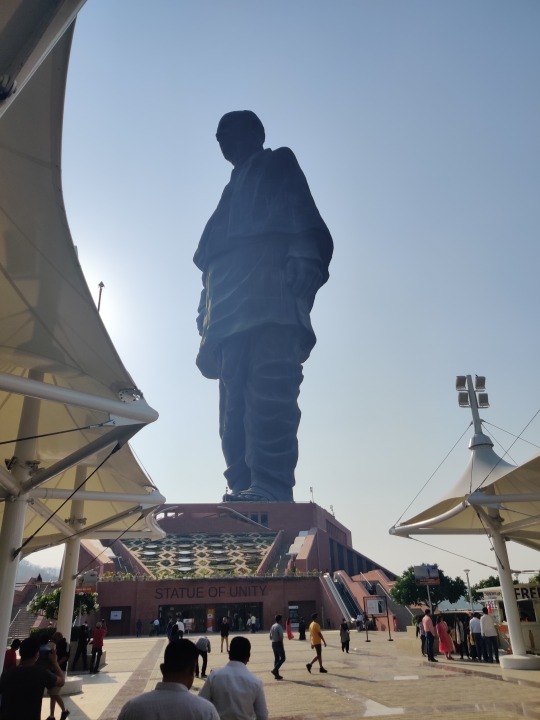
Day-2
Biren and Madhavi joined us in the morning. At breakfast, we decided to skip Sabarmati as going in Ahmedabad would delay our journey. Instead we went to Adalaj Stepwell.
Adalaj Stepwell
The flamboyant 15th-century stepwell, with intricate carvings on the pillars that support the five storeys are mostly intact; the beams work as pit stops for pigeons flying in and out and the structure still leaves jaws dropped for swarms of people. The step-well represents the Indo-Islamic fusion architecture that percolated through the many stepwells of the period. The opening in the ceilings above the landing allows light and air to enter the octagonal well, but direct sunlight never touches the steps except at noon. It is said that the temperature inside the well is six degrees cooler than outside. The stepwell has three entrances. The stairs lead to an underground storey, which has an octagonal opening on top. The walls are covered in ornamental carvings with mythological and village scenes. You can read about it more here
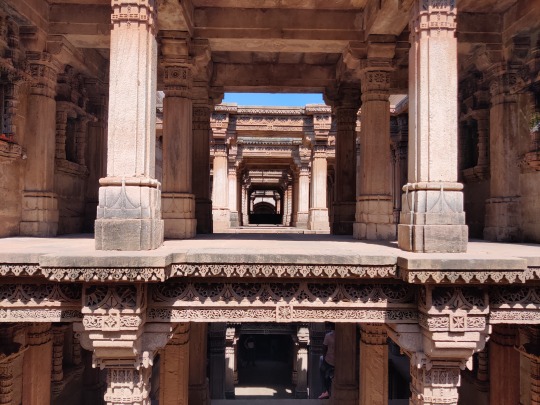
Rani-ki-vav, Patan
Next stop was Patan, the world heritage site of Rani-ki-Vav. This is one of the oldest and finest stepwells in Gujarat and is remarkably preserved. Steps lead down through multiple levels with lines of carved pillars and more than 800 sculptures, mostly on Vishnu-avatar themes, as well as striking geometric patterns. The stepwell is made in the form of an inverted temple. It showcases superior craftsmanship of the era, and the unique Maru-Gurjara architectural style. The stepwell was built in 1063 by Rani Udayamati of the Chaulukya Dynasty to commemorate her husband, Bhimdev I. The stepwell was commissioned in 1063 and was completed after 20 years. Archeologists Henry Cousens and James Burgess visited it in 1890s when it was completely buried under silt and only the shaft and few pillars were visible. The stepwell was rediscovered in 1940s, and the Archeological Survey of India restored it in 1980s. The stepwell has been listed as one of UNESCO's World Heritage Sites since 2014. Read more here
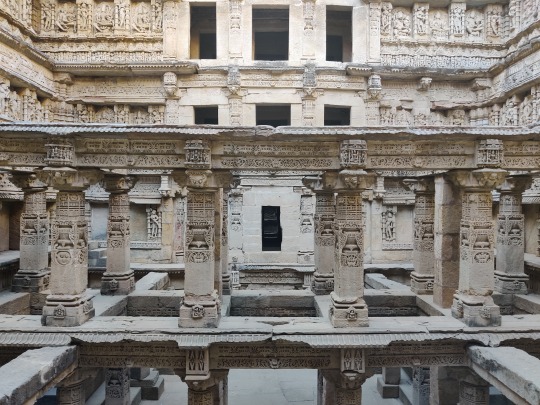
Sun Temple, Modhera
The guide we hired here told us to go to Modhera also. So we went to Modhera before the close of the site for the day. Modhera is an ideal destination for being away from the hustle-bustle of city life for a day. The unruffled peaceful landscape and the majestically welcoming temple complex will ensure to take you away from the mundane routines of daily. As you enter the historical complex, you first come across the magnificent kund known as the Ramakund, built in rectangular shape containing 108 shrines to various gods and demi-gods. There are three main shrines positioned on the three sides of the kund, dedicated to Ganesh and Vishnu and an image of Lord Shiva dancing the ‘tandav’ facing the temple of the sun which covers the fourth side. The twelve representations carved on the pillars represent the sun according to the twelve months. The statue of the sun god no longer exists. More about here

Reached Rann Riders, Dasada, Little Rann of Kutch in the night. During the night you can miss the sign board, while reaching advised to go slow so that you can take a proper turn to reach the resort. We met Cyclist Brajesh Sharma who was going live on YouTube from the Nature Zone. He is on All India Tour on cycle to create awareness about dangers of using plastic in general and single use plastic in particular. He regularly interacts with the schools, colleges on his tour which he started a year back. Follow him here
Day-3
Little Rann of Kutch
Morning after breakfast, went for the dry land safari in the Wild Ass Sanctuary and wet land safari in the evening. Being the world’s only natural habitat for wild ass, the sanctuary of course draws people to watch these magnificent creatures. However, the sanctuary harbours a large variety of bird population. The Rann was a shallow part of the Gulf of Kutch earlier. It is formed through the process of siltation of marine estuary. During monsoon, the Rann becomes a vast shallow sheet of water which dries up by October, November. Flamingos, Pelicans, Spoonbills, Glossy Ibis and Painted Storks etc were seen by us. We saw Brahminy Duck, Sandgrouse, etc. also.
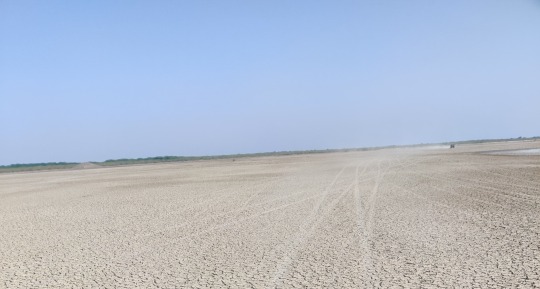
Day-4
Left for Dholavira for Harappan Excavation another UNESCO World Heritage site. This was the highlight of the trip. As all you know, every such trip has a highlight and a place worth visiting, a lifetime achievement. Dholavira was one such place. You are reminded of the advance techniques used by people more than 4500 years ago. You will not believe until you see such place. Personally, I feel what you are taught in schools about history is nothing when you visit such places and hear from government guides.
Dholavira
Dholavira is the most remarkable excavations of the Indus Valley Civilization or Harappan culture, dating back to 4500 years ago. What Dholavira offers you, in the intense environment that comes with being surrounded by the Great Rann of Kutch, is a unique insight into the pioneering Harappan mind, with one of the world’s earliest and best planned water conservation systems and what might be the world’s first signboards, written in ancient Indus script.
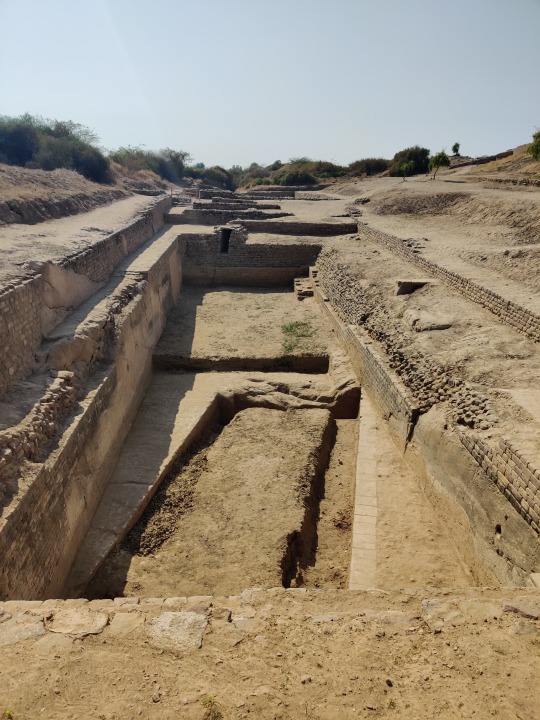
The excavation also tells the story of the 7 stages of the civilization, from development to maturity to decay, the last of which hints at a strange piece of history, with more questions than answers. After the peak of the civilization Dholavira was temporarily abandoned, after which it seems that the settlers returned with a markedly de-urbanized culture. There are hints that they willingly chose to simplify their lives, rather than try to ride the collapse of their once glorified civilization. Here, on the ruins, you will have a chance to contemplate what progress and civilization mean and what, if anything, is truly permanent.
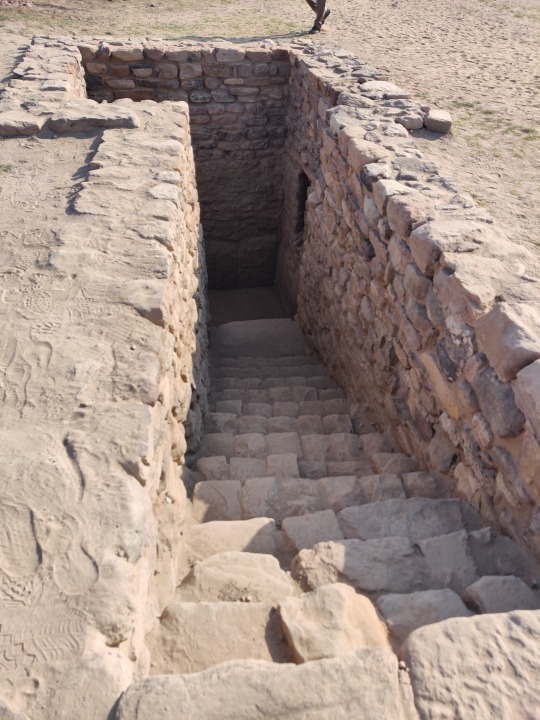
Dholavira, known locally as Kotada (large fort), sprawls over 100 hectares of semi-arid land at the north-west corner of the island of Khadir. It is one of the islands in the Great Rann of Kutch that remain above the flood-plains in months when the rest of the desert is submerged by the monsoon. Dholavira has two seasonal nallahs, or streams: Mansar in the north, and Manhar in the south. The journey to Dholavira itself is beautiful, taking you through the saline desert plains of the Great Rann, where you can spot wildlife such as chinkara, nilgai, flamingos and other bird life.
The site was unearthed by the Archeological Survey of India (ASI) in 1967, but has been systematically excavated only since 1990. It has a museum where all the artefacts are on display. Visit this website for more information.
Chobari
We started for Chobari, Nature Zone, our final stop of the day. The google map shows the wrong route at the last leg. But follow your instincts and go, as the people nearby are helpful. Ashwath drove through a village and people guided properly. When in the map it was showing the homestay is just across, I told him just take a turn instead of going ahead. Just then, I noticed a board showing the way. So, we went first, as the other car followed the google map and was helped by Ramji by sending a person to show the way. It is very difficult in the night and if you are new in these areas.

Meriya Nature Zone is a homestay and bookings can be made through personal contacts. It is yet to be on internet. The homestay is very good with basic amenities. As mobile network is available, no worries about internet connection. Ekal Rann is nearby and the full moon with Rann in background is something to be experienced. For bird lovers, the homestay itself is a heaven as Maharashtra’s state bird Yellow footed Green Pigeon, peacock, red vented bulbul, kingfisher, Domicile’s crane, etc are plenty. Just outside the homestay, there is a water body, where lot of coots, cormorants, ducks, shag, etc can be seen.
Day-5
Ekal Rann
Noel and others went for nearby bird watching where hordes of peacock, common cranes, calves feeding takes place and came back. The other group enjoyed the bird watching and village experience chitchatting under the tree in the homestay. As we have not decided about our further stay at Nakhatrana/Bhuj, Ramji Meriya suggested us Jugal Tiwari at Nakhatrana. We finalised the stay at Nakhatrana, Centre for Desert and Ocean (CEDO) for two nights. In the evening we went to Ekal Rann for sunset and full moon. We saw flamingos and cranes in thousands. The slushy road in between leads to Dholavira but only when it dries. Ramji was telling that due to excessive rains this year, it has not dried up. He also remembered his pioneering effort of bike rally from Ekal to Dholavira and back.
Day-6
Bhuj
After breakfast, we started off to Bhuj, and straight went to Aina Mahal but unfortunately, we reached around 12.30 pm. It is closed between 11.45 am and 3.00 pm. Then, Noel suggested to go to his friend’s hotel (Hotel Annapurna, near Bhid Gate). We thought of getting our RT-PCR done and enquired with Gor and Jugal Tiwari and agreed to do it in Bhuj before proceeding further to Mandvi and then to Nakhatrana. Bhagat lab, Bhuj does the RT-PCR in Bhuj.
Mandvi Beach
We then went to Mandvi beach and spent time. There must be some other point where seagull, spoon bill etc, are plenty. The beach point is very crowded with camel ride, boat ride, joy ride etc. and bustling with lot of people. We were wondering where this corona went?
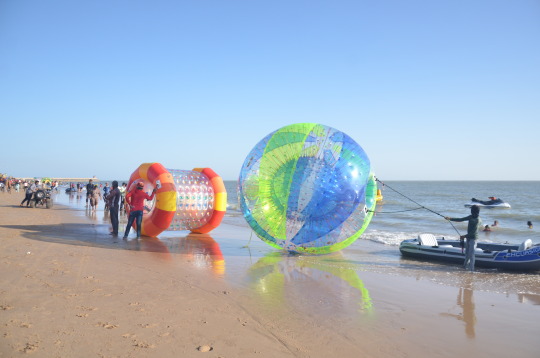
Reached Moti-Virani village, where CEDO is situated and here came to know about Jugal Tiwari is ex. BNHS person. He was also pleasantly surprised to know about us being BNHS members. The booking at CEDO is through internet only and some times through contacts known to him. In our case Ramji Meriya. No bookings on go and knock.
Day-7
Lakhpat, Narayan Sarovar
Mata-no-Madh, Ashapura Temple
After breakfast, we started for Lakhpat the fort town. On our way we stopped at the Mata-No-Madh Ashapura Temple. This shrine is steeped in antiquity as far as its origin is concerned. Today there is no trace of any ancient records or writings which give any indications of the beginning of worship at this shrine. One fact firmly stands out that this deity was very much there in 9th century AD when the Samma clan of Rajputs from Sindh first entered western, or more correctly, north-western Kutch. They were followed in the later centuries by more families or this clan which eventually established them in the region and one of their line got control of the whole state of Kutch in the beginning of the 16th century. Then we went to Siyot Caves. It is a small Buddhist cave as the name suggests. From Siyot to Lakhpat, the road after passing a village was only bushes and mud road. Though the google map shows it as Siyot-Lakhpat Road, it is a challenge to drive on this road which joins the Gaduli-Lakhpat Road at the end.
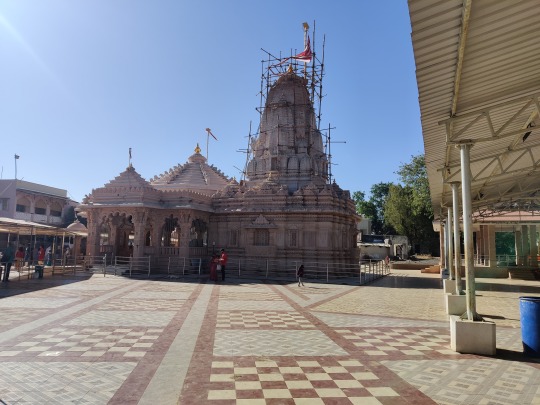
Lakhpat
Lakhpat Fort with a walled fort, was an important coastal trade node in the 18th century. At the mouth of the Kori creek, the large fort walls still offer testimony to a short but glorious past. One can climb the fort rampart, the only remaining structure of the fort, and look over at the placid sea. This spot is particularly stunning at sunset. Within the fort walls, also lies a 16th century gurdwara. It is believed that Guru Nanak stopped here twice during his second (1506–1513) and fourth (1519–1521) missionary journey called Udasis. The gurdwara is a soothing spot for travellers. The soft hymns play constantly in the background, as travellers visit the ancient Sikh place of worship to see relics like wooden footwear, palkhi (palanquin), manuscripts and markings of two important heads of Udasi sect. We had prasad at the Gurudwara Langar.
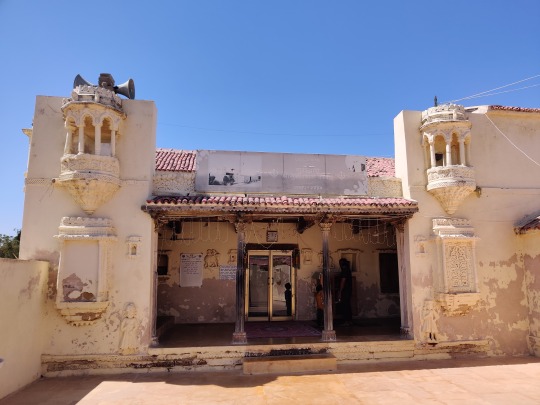
More than 200 years old, the fort is named after Rao Lakha, who ruled in Sindh about the middle of the thirteenth century. It fell to ruins through the century, as trade depleted, and the people in the town migrated to fairer pastures.
Narayan Sarovar
Narayan Sarovar Temple has great spiritual significance. This is one of the 5 holy lakes of Hinduism, along with Mansarovar in Tibet, Pampa in Karnataka, Bhuvaneshwar in Orissa and Pushkar in Rajasthan, and is considered a coveted place for a holy dip. The origin of Narayan Sarovar dates back to the Puranas. It is said that there was a drought in the region, and Lord Vishnu appeared in response to ardent prayers by sages. When he touched the land with his toe, a lake was immediately created, alleviating the locals from their misery. An adjoining temple built by the wife of Maharao Desalji features shrines of Shri Trikamraiji, Laxminarayan, Govardhannathji, Dwarkanath, Adinarayan, Ranchodraiji and Laxmiji. Madhavi was excited to know about Vallabhacharya, who had baithak at this place. She interacted with the pujari of the temple to know more about it.
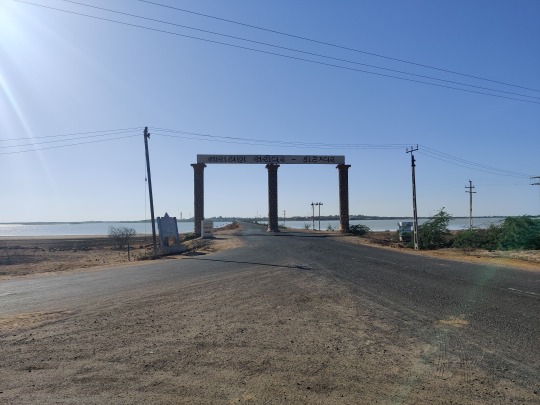
A short drive from here, the Koteshwar Mahadev Temple is a grand sandstone structure that overlooks a marshy sea. Shrines dedicated to Shiva and Ganesha are the highlights here. Koteshwar Temple, at a place where the immensity of dry land meets the incomprehensible vastness of the sea. It is the last outpost of human construction and the temple at the westernmost limit of India. The story of Koteshwar begins with Ravana, who won a boon from Lord Shiva for an outstanding display of piety. This boon was the gift of a Shiva linga of great spiritual power, but which Ravana, in his arrogant haste, accidentally dropped and it fell to earth at Koteshwar. To punish Ravana for his carelessness, the linga turned into a thousand identical copies (some versions of the story say ten thousand, some a million; suffice to say it was quite a lot.) Unable to distinguish the original, Ravana grabbed one and departed, leaving the original one here, around which Koteshwar Temple was built. Visitors can see the temple, walk along the beach and on a clear night, even see the glow of light from Karachi, Pakistan, on the north-western horizon. One more observation was that the flag is so long that it touches almost the sides. Never seen temple flag so long.
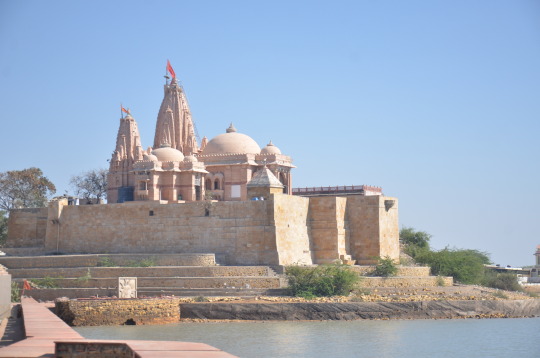
On our way back, we were looking for the tropic of cancer line which we could not find while going. To our delight, we found the board but the markings on the road is not at all visible may be due to asphalting of roads and ignorance of the contractor who laid the road.
We skipped going to Nirona village for award winning rogan artistes, bell makers, Lacquer works due to paucity of time.
Day-8
We started after our breakfast for Vadodara. Wait. Jugal Tiwari wanted to show us his fossil collections which was spellbound. He explained patiently and offered his help those students for their academic purpose. He also showed us the bell works and rogan art which he sells to guests as promotion of cultural appreciation. After exchanging pleasantries, we left for Biren’s house. The drive was a long one. We took a different route in which the road was not at all good as compared to arterial roads. Hence, we reached Vadodara at least 30-40 minutes after they reached. Noel went to his daughter in law’s place. We had a on the go Vadodara darshan in Biren’s vehicle. Meera Madam revisited her student days. We purchased some sweets and savouries for our contacts and colleagues in Mumbai. Else you will be stuck for response for it will be like Returned and had dinner at Biren’s house.
Day-9
Left early around 7 am. Biren dropped Commander and Meera at the designated spot to meet Noel. Transferred the luggages accordingly. Off we went to Dandi.
Dandi
The 'National Salt Satyagraha Memorial', Dandi, is conceived as an experiential journey recreating the spirit and the energy of the 1930 Dandi March led by Mahatma Gandhi and 80 of his fellow Satyagrahis, taking the visitors to the Monument step-by-step in order to visualize and understand the history of the historic Salt March and the methodology of Satyagraha, which finally led to India’s Independence. As Noel asked us to visit his factory at Vasai, off we went from Dandi to Vasai. We reached first and was waiting who joined after half an hour. Noel showed us his factory and his award-winning instruments. We said good-bye with lot of memories of the fascinating trip. Dropped Meera Madam at her place and returned to Kalyan west at sunset.
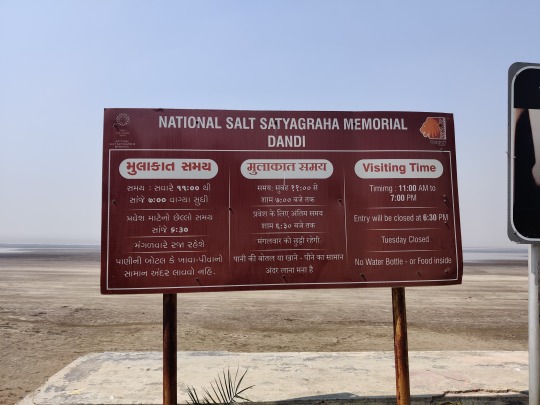
Note:
In view of Corona, we followed the safe procedure like wearing mask always when stepping out, in car, etc.
Did RT-PCR for each person for crossing the state border even though there was no check.
Thanks to Noel and Ashwath our excellent drivers. Commander for a brief change drove a portion of the trip.
--- ---
0 notes
Text
Historical Monuments printed on Indian Currency
India has a magnificent history. All of it is beautifully reflected in the architecture and monuments that the country is adorned with. Some of them are as old as a thousand long years. Historical Monuments printed on Indian Currency will give you an overview of the country’s illustrious past. Let’s take a tour then! After the demonetization of the Rs 500 and Rs 1000 currency notes on November 8, 2016, we’ve seen 7 new currency notes from the Reserve Bank of India (RBI). The new Indian banknotes with value 100, 200 and 500 rupees depict three of the most beautiful Historical Monuments.
Rani Ki Vav on 100 Rupees Banknote
Rani Ki Vav or ‘Queen’s Stepwell’ is a distinctive form of water storage system located in the small town of Gujarat called Patan, on the banks of River Saraswati. Being one of the prominent attractions of Gujarat, Rani ki Vav is visited by a lot of tourists. The architecture and historical relevance of this beautiful stepwell are commendable.
This astonishing structure is built in the complex Maru-Gurjara architectural style. The unique stepwell is constructed by Chaulukya dynasty Queen Udayamati in memory of her late husband, King Bhima I. It is 64 m long, 20 m wide & 27 m deep and is known for its stepped corridor and pillared multi-storey pavilions. It has a 30-kilometre tunnel, currently blocked by stones and mud, which is connected to the town of Sidhpur near Patan.
There are more than 800 elaborate sculptures being carved on the inner walls of the stepwell. The central theme is the Dasavataras (the 10 incarnations of Lord Vishnu). The other sculptures are of sages, apsaras (celestial dancers) and Brahmins. Some sculptures show Nagkanya, Yogini beautiful women and fairies, showcasing 16 different styles of make-up (Solah-Shringar).
A masterpiece of architecture, Rani ki vav is the only stepwell declared as a UNESCO World Heritage site. It is also featured on the Lavender coloured 100 Rupees Banknote issued by Reserve Bank of India.
Sanchi Stupa on 200 Rupees Banknote
For the first time in history, India gets a banknote of Rs.200!
This new denomination illustrates on its reverse a famous Buddhist monument, the Sanchi Stupa, depicting our country’s diverse cultural heritage. Based in against a Bright Yellow colour, this note has other designs and geometric patterns merging with the overall colour scheme.
The moment we hear Sanchi Stupa, our mind goes back to 300 BCE to Ashokan Period. The Great Stupa at Sanchi is one of the most important Buddhist monuments reflecting the gems of Buddhist art and architecture. This Stupa is located in Sanchi Town, Madhya Pradesh, India. It is the oldest stone structure in India and was built during the Mauryan period.
Originally commissioned in the third century BCE by Emperor Ashok, this huge hemispherical dome has a height of 12.2816.46 m (54.0 ft) and consists of a central chamber where the relics of Lord Buddha are placed. It was further expanded by the Shunga rulers.
When we are talking about Historical Monuments printed on Indian Currency, this particular Buddhist monument has a special significance.
Red Fort on 500 Rupees Banknote
The Red Fort was built as the palace fort of Shahjahanabad: the new capital of the 5th Mughal Emperor of India, Shahjahan. It gets its name from its massive enclosing walls of red sandstone.
On the auspicious day of Muharram, the construction of Red Fort began. Supervised by the emperor Shahjahan himself, the foundation of the fort was laid on 13th May 1638. Built-up by red sandstone, the name Lal – Quila speaks for itself.
In 1638, Shahjahan transferred his capital from Agra to Delhi and laid the foundations of Shahjahanabad, the seventh city of Delhi. Enclosed by the stone walls and gates, the royal residence – Lal Quila or Red Fort stands impenetrably by the North Frontier of the City.
The imperial apartments consist of a row of pavilions, connected by a water channel. The fort complex is considered to represent the zenith of Mughal creativity under Shah Jahan and although the palace was planned according to Islamic prototypes, each pavilion contains architectural elements typical of Mughal buildings that reflect a fusion of different architectural tradition.
The Red Fort not only is a fine specimen of architecture, but also a sturdy witness of the history of India. Being the capital place of the Mughal Empire, the Red fort silently speaks about the rise and fall of the Empire, celebrations of festivals, and periods of crisis and declarations of the wars. The fort also witnessed the zenith of the Mughal Empire as well as the domination by the Maratha Empire and finally the captivity by the British. The Fort still stands valiantly and proudly sees the hoisting of “Tiranga” on 15th of August every year since 1947.
This Heritage Monument of utmost importance appears on the new INR 500 notes! It is an incredible specimen in Historical Monuments printed on Indian Currency series.
India is one of the most beautiful countries in the world and is best known for its colourful culture and fascinating heritage. These beautiful architectural wonders truly represent the respective nation’s cultures and traditions. This new Banknote has a special significance when we mention about Historical Monuments printed on Indian Currency. Please wait for our next Blog to know more about other charming Indian monuments.
Till then keep collecting…
Share
The post Historical Monuments printed on Indian Currency appeared first on Blog | Mintage World.
0 notes
Text
At the Modhera Sun Temple in Ahmedabad
they all, universally, asked, “why?” Ahmedabad is famous for its textiles – we have been told many times since arriving that it was the “Manchester of India”. Gandhi is in part responsible for this – he helped organize the textile workers of Gujarat, his home state, as part of his campaign to rid India of the British. The 5th largest city in India, with a population of about 5 million (in Gujarat, the only dry state left in India, with a population of about 53 million), Ahmedabad City is a big, industrial place – well off the beaten tourist track and not pretty. The fact of the matter is that we have no idea why we are here – when we told the company that organized our tour of India that we wanted to go to Udaipur and Jaisalmer, we were presented with an either-or proposition: Jaisalmer and Jodhpur; or Udaipur and Ahmedabad. We wanted Udaipur more than Jaisalmer, and so we are in Ahmedabad.
No Regrets: Three Spectacular Sites
But after our 1st day touring some places to visit in Ahmedabad, we have absolutely no regrets about being here. We visit 3 spectacular sites (and sights) today and see parts of India that very few tourists ever get to – as our guide said, we saw “the real India” – and our hotel here is wonderful, quiet, calm, beautiful, a real sanctuary from the real India outside.
First is the Sun Temple, 2 hours north of Ahmedabad in Modhera. Built in the 11th century, it is in amazing condition. Frances, our guide (from Goa, and thus with a Portugese name) tells us that the temple is laid out so that when the sun rises on the equinoxes, it will strike the wall of the sanctuary. The carving throughout is exquisite. He says that the human level (like many traditional Hindu temples, there is a hierarchy of levels throughout the carving – demon below animal below human below god) is all about sex education. And despite a millennium of exposure to weather, war, earthquakes, and air pollution, the graphic details are there.
John and His New Friends at the Rani-ki-Vav
There is a group of schoolchildren and their teachers visiting the Sun Temple, celebrating the end of the school year. They mob Greg and me – they want to shake our hands, say a few words and get our autograph. Our guide later tells us that they are from a small village not too far away, a village where non-Indians almost never go. Second is the Rani-ki-Vav, a step temple built at about the same time as the Sun Temple, and not too far away. Step wells are multi-level affairs, all with a spring-fed pool on the lowest level, designed to be refuges for Queens from the intense heat of the Gujarati summer. Rani-ki-Vav was discovered only in the last 30 years, having silted up over the years. Again, we are overwhelmed by the beauty of the place, and the quality of the carving. From Rani-ki-Vav it is a short drive to Anhilawada Patan, the capital of Gujarata until Ahmed Shah moved the capital to his new city of Ahmedabad in 1411, and the reason that both the Sun Temple and Rani-ki-Vav are located here. Nearby Patan looks and feels and smells like a city that has not changed much since the middle ages. More than anywhere else today (and there are lots everywhere else today – even on the toll motorway we take from Ahmedabad to Mehsana), there are cattle, water buffalo, camels, goats, dogs and the occasional cat in the streets. The only animals that are missing that we’ve seen elsewhere on the streets here in India are elephants and monkeys.
A Patola in Patan
In Patan there is a patola – a traditional silk loom where the threads are dyed in a most amazing way with vegetable dyes while tied in long bundles – maybe 2 metres long by the width of your little finger. They are then put onto the loom and woven, and the colours in both directions match so that the design is the same on both sides. The process is amazing to see – and the quality magnificent: it takes about 4 months to weave a panel of about 3 metres x 1.5 metres. Handed down as a trade from father to son, there is now only this 1 family in all of India doing it, down from 800 families 50 years ago. We stop for lunch just outside the town of Mehsana at a restaurant that Frances says is delicious (it is) and “hygienic” (we can’t say for sure, the dishwashing process left a bit to be desired). We are the only non-Indians for miles around, and all of the families in the restaurant stop eating as we enter. From then until we get into the car, the children shyly come up to us, politely introduce themselves and ask where we are from, while their parents, equally shy, encourage them with hand gestures.
Another Beautiful Step Well in Adalaj Vav
Third is the Adalaj Vav, another stepwell, just outside Ahmedabad. Built in the late 1400s, it has survived pretty much intact since then, although until recently it was used by the villagers to wash their clothes and as a well, and as a bathhouse for the women. And for the 3rd time today, we are overwhelmed by the beauty and skill on display.
World Traveler, Writer, and Blogger, Co-Founder and Editor-in-Chief of the tripstations.com travel blog. A former Actor, current shower-singer, and non-hipster foodie. Loves his week-end house in St Marys, Ontario. Dad to Sophia, Ariel, and Hastings three of the best cats in the world.
The post At the Modhera Sun Temple in Ahmedabad appeared first on Tripstations.
from Tripstations https://ift.tt/33aivax via IFTTT
0 notes
Photo
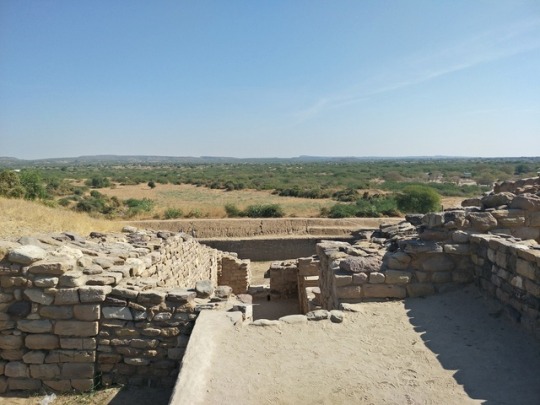
Historical places in Gujarat The state of Gujarat has played a significant role in history. The lands of Gujarat witnessed some brave kings and their rich heritage. Gujarat is also the birthplace of Mahatma Gandhi, the father of the nation, who initiated out various movements for India’s independence from here. The city of Ahmedabad, which is the heart of Gujarat has been recently titled as ‘World Heritage City’ by the UNESCO. Here are some of the places of historical importance and which one must visit and which would give you the feel of the rich ancient heritage and the struggle of Gujarat. Somnath: The Somnath temple is believed to be the first among the 12 Jyotirlingas of Lord Shiva. The shivling at the temple is believed to be ‘swayambhu’ or self-born, manifested in the temple. This temple was destroyed six times and rebuilt every time. The current structure of the temple, seventh reconstruction, is a magnificent edifice built in the Chalukya style of architecture by the master masons of Gujarat, known as Sompuras. Soma, the Moon god, is believed to have lost his luster due to a curse, and he bathed in the Sarasvati River at this site to regain it. The name of the town Prabhas, meaning luster, as well as the alternative names Someshvar and Somnath ("The lord of the moon" or "the moon god") arise from this tradition. You can also visit the beach, and the museum, close to the temple, which exhibits 1638 pieces from 7th to 15th century. Palitana: Located atop the Shetrunjai Hill, Palitana temple is one of the most sacred Jain temples in India and is known for its 3000 brilliantly carved temples. According to the records, there are approximately 108 large temples and 872 small shrines with about 7000 images total that have been built over 900 years from the 11th century by the Jain community. To reach the temple, one will have to climb 3800 steps. For the elder, palanquin (palki) service is easily available. The panoramic view of Palitana unfolds itself as one progresses to the temple. From the top of the temple, you can see the panoramic view of the Gulf of Cambay and countryside. Note: Devotees usually start their climb early in the morning and make their descent by evening as staying at night is not permitted. Dholavira: 250 km from the Bhuj district of Gujarat nestles an ancient town, Dholavira; that throws the light on the Harappan culture and its magnificent civilization. Second largest in India and fifth largest in the Indian sub-continent, this Harappan site the only place that marks the presence of Harappan culture from 2900 BC to 1500 BC. On a trip to Dolavira, you walk can pass through the sun-dried buildings, 5,000-year-old stepwell, ancient reservoirs. To reach Dolavira, you will have to drive for six kilometers from Ahmedabad. Accommodation options are very limited in Dolavira so; you can stay in Ahmedabad or head to Bhuj for the great Rann of Kutch. Laxmi villas palace: Built in 1890 as the private residence of Maharaja Sayajirao Gaekwad III, Laxmi Vilas Palace is indeed one of the grandest structures in India. Sprawling over an area of 700 acres, the palace is believed to be nearly four times the size of Buckingham Palace and features many buildings like Moti Baug Palace, Makarpura Palace, Pratap Vilas Palace and Maharaja Fateh Singh Museum building. It took Robert Fellows Chisholm, the head architect, twelve years to build this grand building. The property also has a Navlakhi stepwell, Maharaja Fatehgarh museum, and a small zoo, which was resting ground crocodiles. Ahmedabad: Finest creations or should I say the major tourists attractions in Gujarat are not only the efforts of years year rulers but also there is a little bit contribution of the citizenry as well. Pols are distinct residential areas that are unique only to Gujarat, and one can find their significant numbers in Ahmedabad. Ahmedabad has been titled the first “Heritage city” in whole India by UNESCO. There are nearly 174 pols in Ahmedabad, each featuring finest lovely wooden windows, brackets, magical balconies, khidkis, and chowks. Earlier pols were the preferred residence across the different sections of Gujarat society for the feeling of society and identity they evoke. Time has bestowed beauty to pol architecture of Gujarat, making them an ornament of world building. Gandhi ashram: Located on the banks of Sabarmati River, this abode of Gandhi is also known as Sabarmati Ashram. This Ashram, originally called Satyagraha Ashram, holds a special mention in the archives of India as a number of freedom movements were planned here between 1917 to 1930. Mahatma Gandhi also trained activists here to join his movements like Swadeshi movements, non-violence and civil disobedience. Gandhi’s poignant, Spartan living quarters are preserved in Sabarmati Ashram, and there’s an open-air museum that presents an informative and moving record of his life and teachings. The Sabarmati Ashram was also the starting point of the very famous and important movement of history, The Salt March to Dandi which played a significant role in leading India towards independence. Sun temple: Built in 1027 AD, Sun temple is one of the surviving Indian shrines dedicated to God Sun and stands as an epitome of the exquisite Hindu temple of Solanki dynasty. The temple is divided into three parts, which are perfectly aligned from east to west, in accordance with the deity passage of the sun. Inside the temple complex, you can see a suryakand or stepwell, prayer hall (also known as Sabhamandapa) supported on 52 pillars and another room (Gudhamandara) that leads to inner sanctum called Garbhagrah. The temple is a sight to behold during the Modhera Dance Festival. Sun temple is located in the Mehsana district of Gujarat, and one can reach by car or bus ride from Ahmedabad. Polo forest: The temples of Polo, located near Vijaynagar, were built between 10th and 15th centuries under the Gurjara-Pratiharas and later the Rathores as a hiding place from enemies, citizens, angry wives, and even from the sun. While there are number of medieval temples in the polo region of this period, the most notable ones are Sarneshwar temple (still in use), Lakha Dera Jain temple and Shiv Shakti Mandir. Structure and design of the temples reveal Islamic traces in the use of domes and lattice screens; it also follows the layout of Traditional Hindu temples. To reach the temples, you can take a bus or private taxi from Ahmedabad, which is hardly 160 kilometers away. Jeeps are also available from Idar, a town in Sabarkantha, which is 56 km from Vijaynagar. Jeeps would take you till the Polo campsite only; thereupon you will have to trek in the forest to explore the temple. There is only one homestay available at the Vijaynagar. Lothal: Somewhere like Dholavira, Lothal is also a significant site of the Indus Valley civilization excavated in India. Here, you can see a tank, which is believed to be a dry dockyard and is connected by the channel to the old course of the Sabarmati River. To know the place better you can also visit the museum, which showcases 5089 products unearthed from the evacuation like terracotta ornaments, shell and ivory objects, replicas of seal and sealings, tools and potteries yielded from excavations, copper and bronze objects animal and human figurines, weights, etc. To reach Lothal, you can hire a taxi from Ahmedabad and go for a long day trip or travel by train till Gandhigram and thereupon take a bus. Champaner: The deserted city of Champaner, a UNESCO world heritage site, is located in the foothills of Pavagadh. With some area perched on a rocky hilltop and bristling with forts, mosques, temples and palaces, Champaner-Pavagadh Archaeological Park looks like something out of a children’s storybook when it’s seen from afar. A major part of Champaner lies in ruins today, with the remains of many old mosques and palaces reflecting a blend of Islamic and Jain tradition. Also here you can find many Chalcolithic Indian Sites from the Stone Age era. Here one can find eleven different types of heritage monuments belonging to 16th century like tombs, gateways, mosques, temples, fortresses and walls, palaces, and pavilions, helical wells, custom houses. Kevda Masjid and Cenotaph, Jami Masjid, Lila Gumbaj Ki Masjid, Pavagadh fort, Lakulisa temple, and Helica Step-well, are some of the famous places to visit in Champaner-Pavagadh Archaeological Park. The Champaner complex is hardly 50 km away from Vadodara, thus, can be a good option for a weekend gateway. Rani ki vav: Rani ki Vav- as the name says this step well was built by Queen (Rani) of Bhimdeva, Udayamanti. Constructed in the 11th century to preserve ground water, Rani ki Vav came into limelight in 1972 when the area was fully earthed. The main highlight of the stepwell is that its walls that are profusely ornamented with figurative motifs and showcases images of various god and goddesses and their consorts from the Hindu Pantheon. The central part of each storey contains the primary sculpture. Winter is the best season to visit Rani ki Vav as you can enjoy the light shows, cultural events and exhibition at the Rani ki Vav Festival. Dwarkadhish temple: One of the four Dhams (divine abodes of India) and Sapata Turis (seven sacred cities), Dwarkadeesh Jagat Mandir doesn’t need any introduction. The word ‘Dwarka; is made of two words- ‘dwara’ meaning road, and ‘ka’ implying eternal significance. Going by the mythological records, Dwarka was the kingdom of Lord Krishna, and he stayed there for quite an extended period. This five storey temple stands on 72 pillars, which according to the science of archeo-astronomy, is some immense significance. The sandstone plinth and walls of the temples are embellished with panels depicting dancers, elephants, musicians and celestial beings. Along with Jagat Mandir, you can also visit the nearby temples like Bet Dwarka, Okha, and shrines dedicated to Rukmini (Lord Krishna’s Wife), Mirabai, Narsinh Mehta and Shank Narayan. Contact justwravel to plan your itinerary for your trip into history. "Kuch din to gujaro Gujarat mein"
0 notes
Photo

Rani ki vav is an intricately constructed stepwell situated in the town of Patan in Gujarat, India. It is located on the banks of Saraswati River. Rani ki vav was built as a memorial to an 11th-century AD king Bhimdev I. This magnificent east-facing step well measures approximately 64 m long, 20 m wide & 27 m deep. A stepped corridor compartmented at regular intervals pillared multistory pavilions is a unique feature. It was one of the largest and the most sumptuous structures of its type. It became silted up and much of it is not visible now, except for some rows of sculptured panels in the circular part of the well. Among its ruins one pillar still stands which is an excellent example of this period of design. A part only of the west well is extant from which it appears that the wall had been built of brick and faced with stone. From this wall project vertical brackets in pairs, which supported the different galleries of the well shaft proper. The bracketing is arranged in tiers and is richly carved. The minute and exquisite carving of this vav is one of the finest specimens of its kind. Befitting its name, the Rani-Ki-Vav is now considered to be the queen among step wells of India. There is also a small gate below the last step of the step well, with a 30-kilometre tunnel, currently blocked by stones and mud) which leads to the town of Sidhpur near Patan. It was used as an escape gateway for the king, who built the step well in the times of defeat. Use our hashtag #FamousPlacesInIndia and TagUs @FamousPlacesinIndia to get featured. #india #indianforts #indianmonuments #indianarchitecture #indiapictures #indiaclicks #indiatravelgram #indianphotography #travelgram #beautifulindia #photographersofindia #indiatrip #indiatourism #indiaphotos #travelindia #backpackindia #exploringindia #amazingindia #indianhistory #incredibleindia #photographyislife #wanderlust #storiesofindia #follow #followme #followus PC: @through_the_anywhere_door
#followus#indiatravelgram#famousplacesinindia#exploringindia#indianhistory#indianforts#india#incredibleindia#travelindia#beautifulindia#indiatourism#travelgram#indianarchitecture#indiatrip#amazingindia#wanderlust#indiapictures#indiaphotos#indiaclicks#backpackindia#follow#followme#storiesofindia#photographyislife#indianphotography#photographersofindia#indianmonuments
0 notes